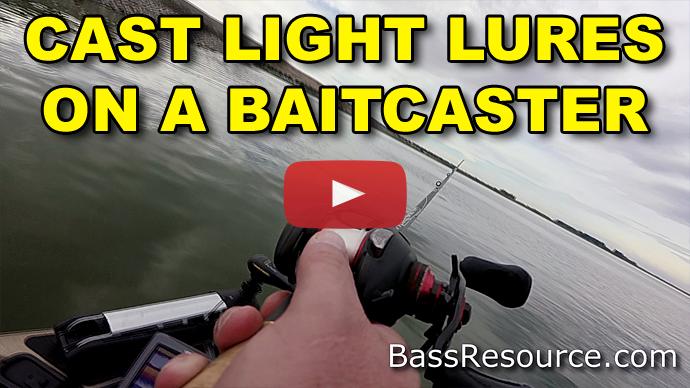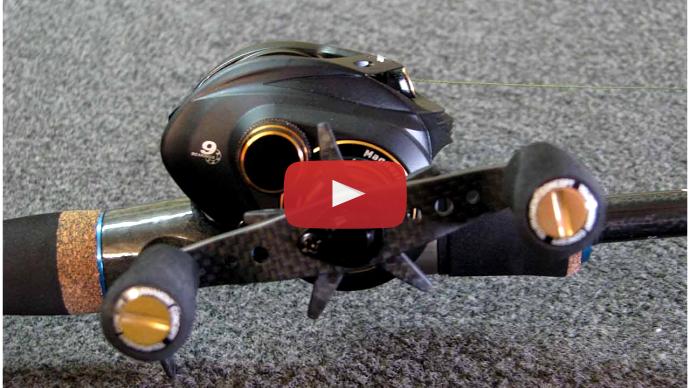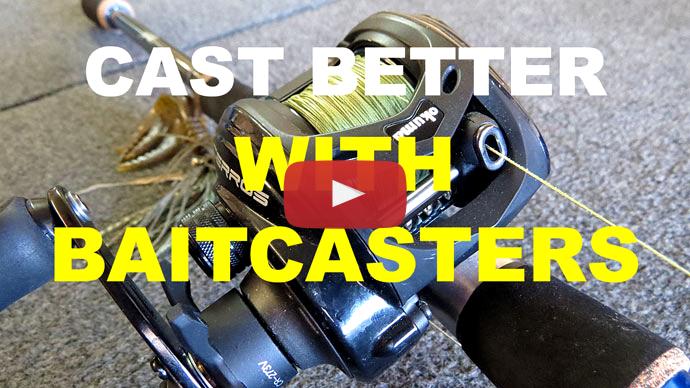What is happening, fishing friends? Welcome, to another episode. My name is Devon, from Debo's Fishing, coming to you today on behalf of KastKing and BassResource.com. Now, I wanna discuss casting weightless baits. Weightless stick baits and flukes can sometimes be kind of tricky, but I've got a few things here that will hopefully help and make that process a little easier for you. Now,the first thing people bring up when you talk about casting a weightless stick bait or fluke is the reel. And the reel is extremely important, but there's a couple things that I look for when I'm picking a reel for a weightless bait.
Number one thing for me is a light spool. You can see how this is all whiffled out, drilled out. This is a very, very light spool. That's why I think a reel like this does the absolute best at casting a weightless bait because it doesn't take as much power or weight to turn that spool. It's a much lighter spool. In comparison, when you look at a reel like this, a reel that has centrifugal brakes on at the actual spool, it's gonna take more weight and more power to actually rotate that spool because it's heavier. Now, this isn't all completely bad because if you're somebody that has issues with your reel backlashing at the beginning of the cast, that's what these centrifugal brakes are made to do. It's got little pins that kick out and rub on the inside ring of your side plate, and that slows that cast down at that initial burst. It helps stop that.
So if you're somebody that has issues with that, I would recommend starting with a reel like this if you have one, and then moving up to a reel that has a lighter, more freely spinning spool like this. Now, after you have your reel selected, I move on to the line. Yes, line plays a very important part in casting weightless baits as well. Because I'm pretty comfortable with it, I actually run 20 pound fluorocarbon on my weightless stick bait setup, but for somebody just starting out, I would recommend a smaller diameter line just to get used to casting it.
Now, I wouldn't recommend it when you're casting into, you know, cover anything using a like a 10 pound diameter because it's gonna be obviously a lot more likely to break off, but a smaller diameter line or starting with a braid, like a 20-pound braid is a good place to start. The braid especially, because it doesn't have any memory.
Moving onto the hooks. Now, I know this probably sounds like, "Well, yeah, I know the hooks make a big difference," but it's something that I don't think people think about a lot. When you're comparing the hooks of different baits that you can be using, there's a wide variety. Now, this is my choice. I go with a 4/0 extra-wide gap, heavy wired hook. And you compare that to just a regular 2/0 extra wide gap hook, there's a significant difference, and not only a difference in the size, but also the weight.
So if you're somebody that's having troubles with the hook and maybe you're using a smaller hook, move up to a heavier hook, to a larger hook, and it will definitely help you cast that bait farther. Last but not least is the actual stick bait that you select. They're not all created equally. Take, for example, this stick bait. It has a very low salt content. It sinks very, very slow and wiggles. Now, a bait that has less salt in it is gonna weigh less. A bait with more salt packed inside there is gonna be heavier and going to be easier to cast.
Compared to a stick bait like this, this is a different type of looking stick bait, but is much heavier when you compare them next to each other. It's bigger, and this bulb on the back is actually pretty dense. So if you're having trouble with the stick bait that you're using, look for a little bit bigger stick bait. Instead of a 5-inch, maybe move up to a 6-inch, or look for a different style that's got just a little bit more weight.
Speaking of weight, I could not wait to get out here and do some field testing in a field, if you will. Another round here, I want to go over the rod that I am using, what you'll wanna look for in a rod when you're picking one for throwing weightless baits. I'll go over the cast that I think will help you and the cast that I use, the things to stay away from when you're casting, and then how to troubleshoot your issues. So if you're still having backlash problems, how do you troubleshoot it and figure out what you need to fix?
So the rod. The rod I am using is the KastKing Perigee II. Now, the reason I like this rod so much is because of the tip-to-backbone ratio. So when you look at this tip, it's roughly 25-ish, maybe I would say, 25-ish tip. The rest is backbone, 75% backbone. You wanna have a good ratio like that. A little bit more tip that's gonna bend and flex, so you can throw that lure, but you have to have a good backbone because, remember, you're fishing a lure with one hook. You have to be able to make sure that you can get that hook penetration.
Now, I am using... This is just a 5-inch stick bait, weightless, with a 4/0, heavy wire, extra wide gap hook. Remember, the heavier wire hook you use, the heavier the hook is going to be, the easier it's gonna be to cast a bait like this. So step up your hook and go to a little bit heavier wire. Now, I am using 20 pound fluorocarbon. I would not recommend that for a beginner. I would drop down to like some cheap, maybe 12-pound or 15-pound mono just to get the feel of it, understand the cast, then you can start moving up to a fluoro. You could even start on a braid. Braid casts really well on weightless lures too. But you wanna watch for that good backbone.
Now, when you're selecting a rod, it's tough. I can't tell you exactly what type rod because for the industry, it's not a standard. So if they say a fast tip, because that's what this is, a fast, not all of them are gonna be maybe 25%. Some of them could only be about 20%. So you just have to, kind of, play with it and get a feel. So the main cast that I use when I'm throwing a weightless bait is the sidearm or roll cast, and the reason I like this cast is because it keeps your lure low to the water, low and parallel to it. It's not gonna be the time where you cast it out and there's a lot of hang time, the lure dies, and we'll talk about that more with the overhand cast, and you're not trying to throw it super hard. You ought to leave a little bit more slack in your line than you normally would.
When you're doing this cast, it's gonna be more of a side lob. You wanna let the line and the lure do the work. So I'm gonna take it. You don't wanna have a point in time where you cast with a slack and then it hits with a quick jerk. That's gonna pull a lot of line out and nest up. I see people do that with sidearm casts. So it's gonna be a long sweeping lob, almost like you're swinging a tennis racket, is the way you wanna think of it. And you can do it even one-handed. It's not gonna be a lot of power. You'll want to let the line, the lure, and the rod do the work. It's not arm power. So that's the sidearm.
Now, you can add a roll to it, but again, it's the same thing. I'm gonna leave my line a little bit lower, two and a half feet or so. I'm gonna roll it and I'm gonna make sure that my line stays tight the whole time. I don't want slack in my line. So I'm gonna roll it over and throw it out. The tip of my rod is gonna act like a slingshot and throw that bait out there for me. That's key to this. Now, along with the sidearm and roll cast, I also like to pitch. When you're pitching, you're keeping the lure nice and low to the water. It gives it a nice subtle presentation. You're not casting it out, throwing it hard. You're not giving it a chance to stall in the air and spool up your...bird nest up your spool. It's gonna be a sweep.
And when I pitch this, it's not like I'm pitching a weightless jig where I'm here and I'm just kinda tipping my rod, and I've got a big, heavy lure to go out there for me. You have to put a little bit of force behind it. So when I do this, it's more of a sweep. Again, almost like I'm swinging a racket and throw it out there. You'll be amazed at how far you can actually pitch a weightless bait, especially if you use more of a sweeping motion, you're not gonna put a lot of force on it. It's just the bend of that rod and the lure going out there.
So those are the two casts that I use most. Now, you can use an overhand. Again, the same things apply. Make sure you've got a little bit extra line and you're not gonna power through it. It's not gonna be a big two-hand, power cast like this. It's gonna be mostly my wrist and the lure and rod tip doing the work for me. I don't wanna bomb this, and that's gonna get us into some of the things that you don't wanna do when you're casting. Contrary to what a lot of people think, when you're fishing a weightless lure, you don't wana throw it harder, you wanna throw it softer and lob up more.
The harder you throw it, it's gonna put a big initial burst on that spool, and then as the lure gets out, it doesn't have enough weight to keep pulling the spool. It's gonna pull it really fast and the lure is gonna slow down, but your spool keeps going, and that's what happens when people get that initial blow up. So that's why I tend to stay away from the overhand cast, especially if you're a big, hard, you know, bomb thrower. Just light, cast of the wrist and you can get it out there. You can get some real good distance, but it's not about power. Let the actual stick bait and the rod do all the work for you.
Now, when you do that cast, try to keep the cast down. So you're gonna let it go just a little bit later than you normally would to ensure you're not bombing it in a big arc. It's that big arc is gonna make that lure stall up there in the air and that's when you start to get bird nests in the middle. So people go back, throw it lightly, let their thumb off the spool a little bit, bursts up in the middle. That lure stalls but your spool wants to keep rolling, so if you're having that issue, make sure you're keeping your thumb on it and watching your lure. If it starts to stall anywhere in there or slow down, your thumb should be able to feel that, and that's just gonna come with practice.
Now, going back to the issues at the beginning of the cast, if your reel has centrifugal brakes, those will help immensely. Now, these are a little bit different type of centrifugal brakes, but the ones that are on the inside of your spool here, as soon as you cast, they help on that initial cast a bunch because they're gonna flare out and slow down your lure. So, if you have the centrifugal brakes like that, make sure you turn those on or turn those up a little bit if you keep getting a lot of issues at the beginning of your cast.
Now, if you just have the magnetics like this, I'll just start with them up at 9:00 when it's a windy day like this. It's decently windy out, not horrible, but there is some wind. The magnetic brakes will help at the beginning of that cast too.
Now, lastly if you're having issues when the lure goes all the way out there and almost hit, it starts to backlash up, or when its hit is backlashing up, you're not putting enough pressure with your thumb or you don't have enough of your spool tension tightened up. Your spool tension is what's gonna stop that lure when it hits the water from backlashing. Now, I have my spool set pretty loose right now. So as you'll see, when I let this drop, see how it kept running, all that loose stuff?
Now, if you imagine, there was a whole bunch of force behind that and I actually cast that out, as soon as it hits the water, that's gonna be far worse. This was just a little drop from the tip of my rod, but if you're having those issues, it just means that you need to turn up your spool tension so that spool doesn't keep running at the end of your cast.
Now, as you get more comfortable casting a weightless lure, you can slowly loosen up your brakes a little bit. You can slowly loosen up your spool tension because as you loosen those and allow your spool to spin freer, you're gonna get further distance with your cast. But just remember, if the wind changes or anything like that, sometimes it can be a little bit finicky with such a light lure. So you might have to adjust a couple times if it changes throughout the day. If you're out more on the main lake and there's more wind and you go back into a colve, you can loosen those up a little bit.
Let's get back and recap. The things that will hopefully help you if you're still having some issues casting a weightless lure. Starting with the reel, you wanna look for a reel that's got a good, free-flowing spool that's light. A light spool helps immensely. Now, if you're still having trouble with those backlashes at the beginning of the cast, look for a reel that's got some internal centrifugal brakes. Those centrifugal brakes will definitely help at the beginning of that cast, taming that backlash.
Moving to the line, start with a line that's a smaller diameter or a little softer. A soft mono is really good in like a 10 or 12-pound, or try a braid in 20-pound. It casts really well on bait casters too. And then I like to move up to a heavier line. I like to go as heavy as I can manage just in case you're around sticks or rocks to help with break offs. The hooks move up to a little heavier hook. I like a 4/0 with a heavy wire and extra strong, sometimes they'll call them. It'll help give you a little extra weight to cast that stick bait. When you get to the actual stick bait or fluke, whatever it may be, look for a lure with a higher salt content that'll give the lure a little bit more weight. Try stepping up a size. So if you fish normally like a 5-inch stick bait, move up to a 6-inch. Or look for a different variety of the same type of lure that's a little bit heavier.
So, if you like these type of videos, let me know in the comments below. If you have any types of tips or tricks that help you cast a weightless lure, let me know down below. I would love to hear them. If you're not already following the KastKing channel, please consider doing so for more informative videos just like this. And until next time.



